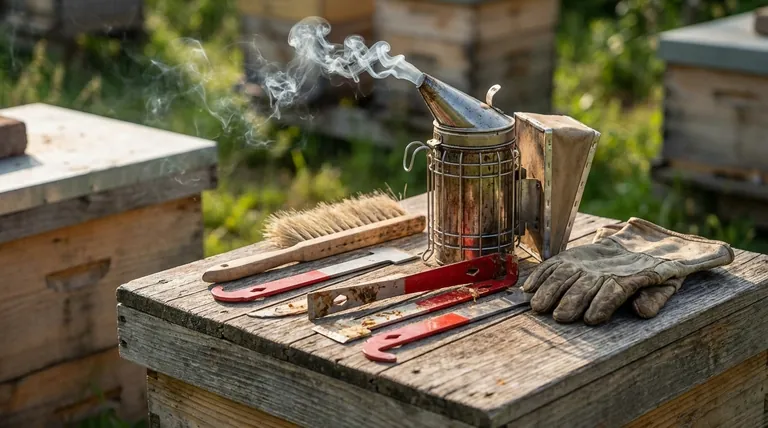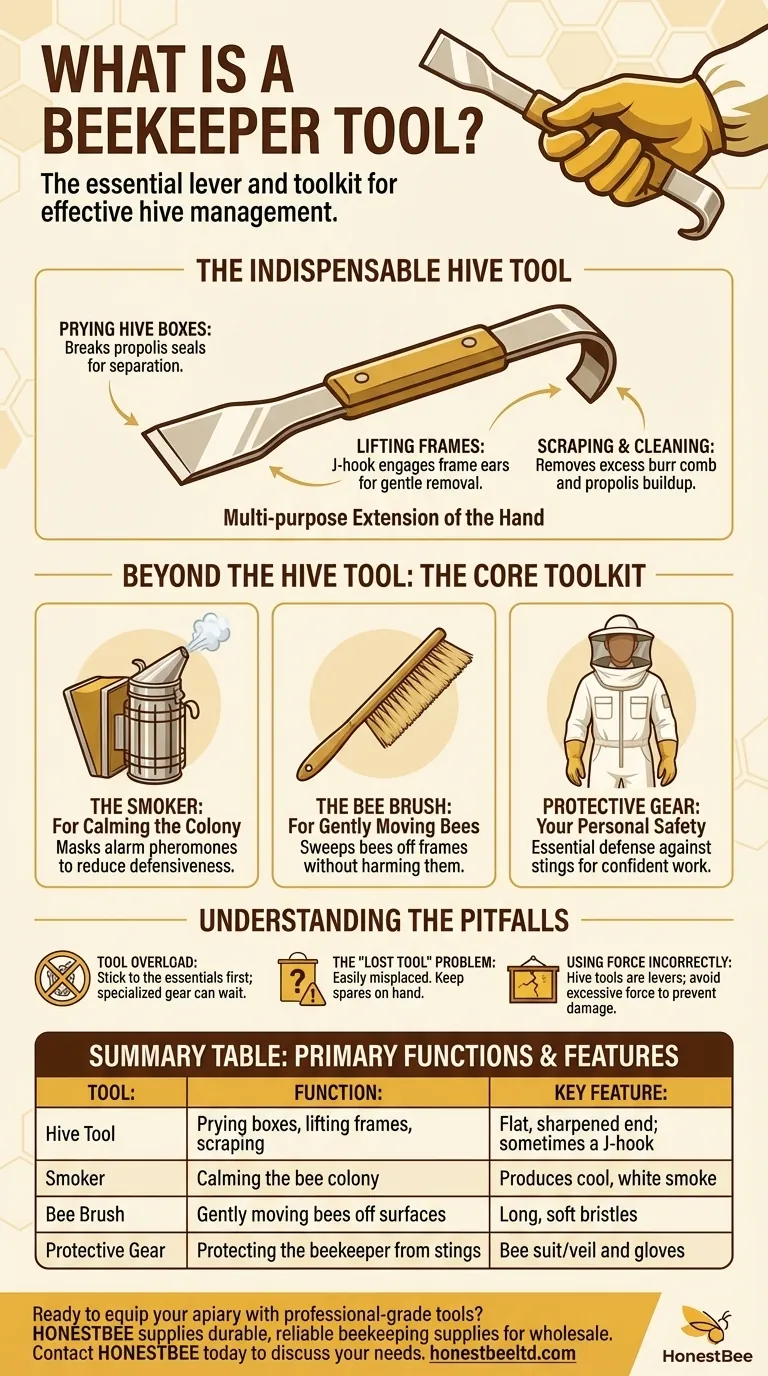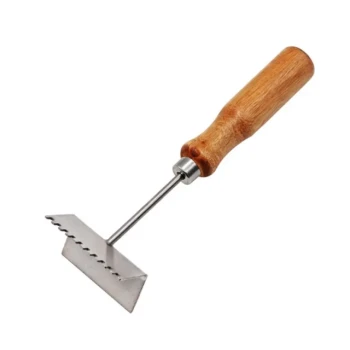At its core, a beekeeper tool is a specialized, hand-held lever designed for managing and inspecting a beehive. It is arguably the single most essential piece of equipment a beekeeper owns, used to pry apart hive components sealed by the bees with a sticky resin called propolis, lift frames, and scrape away unwanted comb or propolis.
While the term can refer to any implement a beekeeper uses, "the beekeeper tool" almost always means the indispensable hive tool. However, a successful beekeeper relies on a small, core set of tools—including the hive tool, a smoker, and a bee brush—to work safely and effectively.

The Hive Tool: Anatomy and Purpose
The hive tool is the beekeeper's multi-purpose extension of their own hands. Without it, performing even the most basic hive inspection is nearly impossible due to the strong propolis seal created by the bees.
Prying and Separating Hive Components
Bees use propolis to seal every crack and seam inside the hive, effectively gluing the boxes and frames together. The flat, sharpened end of a standard hive tool is designed to be wedged between hive boxes to break this seal and separate them for inspection.
Lifting and Inspecting Frames
Once inside a hive box, the frames also need to be loosened. Some hive tools, known as J-hook tools, feature a curved end specifically designed to hook under the ear of a frame, providing leverage to lift it out without damaging the comb or angering the bees.
Scraping and Cleaning
The hive tool's scraping edges are essential for hive maintenance. Beekeepers use them to remove excess burr comb (comb built in undesirable places) and scrape propolis buildup from frames and hive boxes, keeping the components clean and easy to manage.
Beyond the Hive Tool: The Core Beekeeping Toolkit
While the hive tool is critical, it works as part of a small team of essential equipment. Understanding these other tools provides a complete picture of what is required for safe and efficient hive management.
The Smoker: For Calming the Colony
A smoker is a metal canister with a bellows that burns fuel (like pine needles or burlap) to produce cool, white smoke. The smoke masks the bees' alarm pheromones, which helps keep the colony calm and less defensive during an inspection.
The Bee Brush: For Gently Moving Bees
A bee brush has long, soft bristles and is used to gently sweep bees off a frame. This is necessary when you need a clear view of the comb or when harvesting honey, ensuring bees are not crushed or unnecessarily agitated.
Protective Gear: Your Personal Safety
A bee suit or jacket with a veil and a pair of gloves are fundamental safety equipment. They protect you from stings, allowing you to work with confidence and focus on the health of your colony rather than the fear of being stung.
Understanding the Pitfalls
Equipping yourself properly is about more than just buying gear; it's about understanding its correct application and limitations.
Tool Overload vs. The Essentials
The market is full of specialized gadgets, but a beginner only needs a few core items. Start with a reliable hive tool, smoker, bee brush, and quality protective gear. You can acquire more specialized tools later if a specific need arises.
The "Lost Tool" Problem
Hive tools are notoriously easy to misplace in the bee yard, often left on top of a hive or dropped in the grass. Many experienced beekeepers keep multiple hive tools on hand to avoid being caught without one.
Using Force Incorrectly
The hive tool is a lever, but it requires finesse. Using too much force can damage your woodenware, break frames, and kill bees. Always use slow, steady pressure when prying components apart.
Assembling Your First Beekeeping Kit
Your choice of tools should directly support your goals as a beekeeper, whether you're just starting or refining your process.
- If your primary focus is starting with the absolute minimum: Your non-negotiable kit includes a hive tool, a smoker, and a full set of protective gear.
- If your primary focus is performing efficient and safe hive inspections: Add a quality bee brush and a simple queen catcher to gently manage your bees and protect your queen.
Being prepared with the right set of fundamental tools empowers you to manage your hives with confidence and care.
Summary Table:
| Tool | Primary Function | Key Feature |
|---|---|---|
| Hive Tool | Prying boxes, lifting frames, scraping | Flat, sharpened end; sometimes a J-hook |
| Smoker | Calming the bee colony | Produces cool, white smoke |
| Bee Brush | Gently moving bees off surfaces | Long, soft bristles |
| Protective Gear | Protecting the beekeeper from stings | Bee suit/veil and gloves |
Ready to equip your apiary with professional-grade tools?
HONESTBEE supplies durable, reliable beekeeping supplies and equipment to commercial apiaries and beekeeping equipment distributors through our wholesale-focused operations. We provide the essential tools—from robust hive tools to efficient smokers—that empower beekeepers to work safely and effectively.
Contact HONESTBEE today to discuss your wholesale needs and ensure your operation is fully equipped for success.
Visual Guide

Related Products
- Professional Stainless Steel J-Hook Hive Tool
- Professional Stainless Steel Frame Cleaner with Ergonomic Wood Handle
- Wide Adjustable Stainless Steel Honey Uncapping Fork with Scraper
- Professional Wide Blade Honey Scraper for Beekeeping and Honey Processing
- Stainless Steel Scraper for Metal Queen Bee Excluders
People Also Ask
- What is the function of a hive tool in beekeeping? The Essential Multi-Purpose Lever for Your Hive
- Why is a hive tool necessary for beekeeping? Your Essential Key to Opening the Hive
- What are the basic components of beekeeping equipment? Build a Thriving Hive from the Start
- What is a hive tool used for? The Essential Multi-Tool for Every Beekeeper
- What steps are involved in cleaning and sanitizing a hive tool? A Guide to Effective Apiary Biosecurity



















